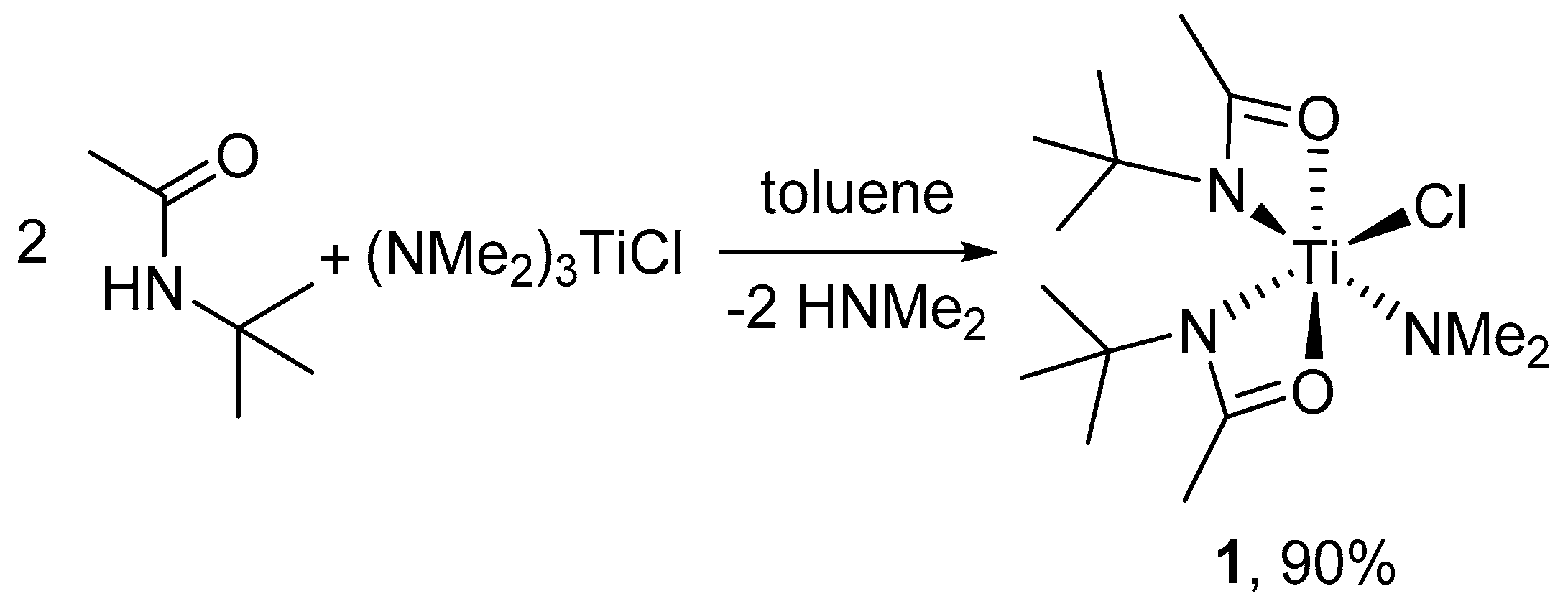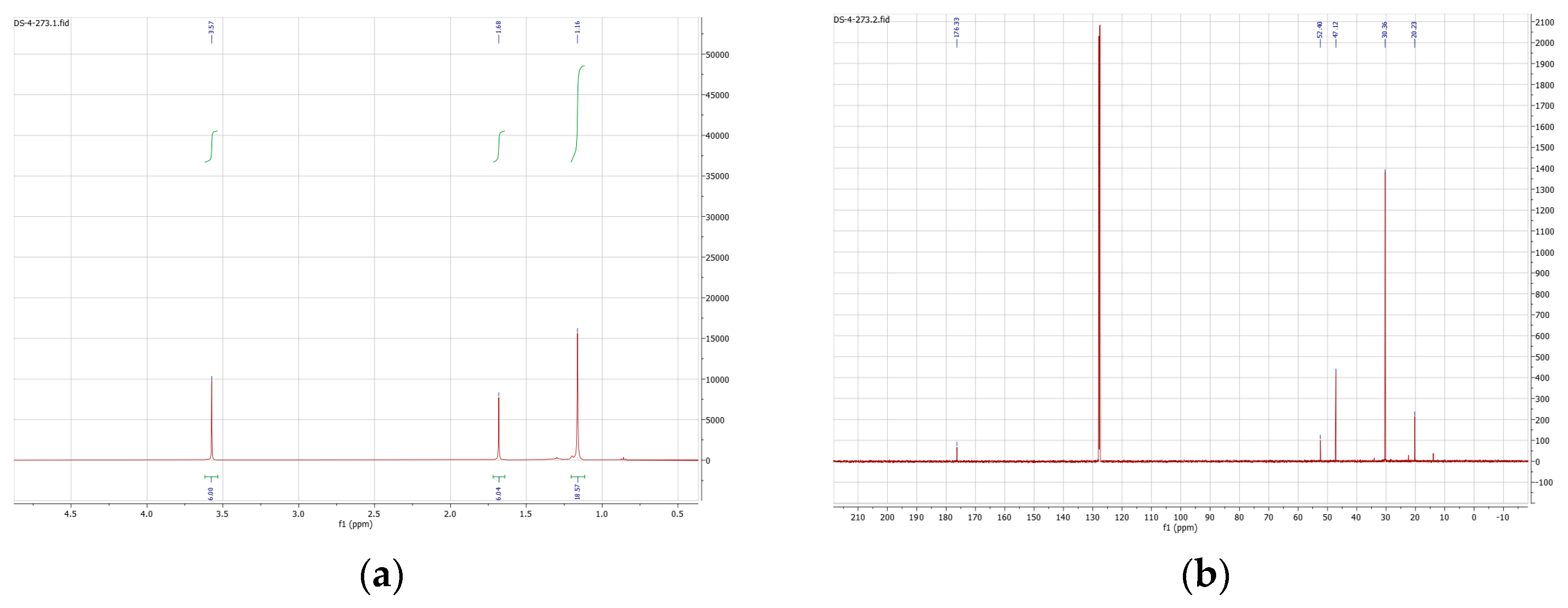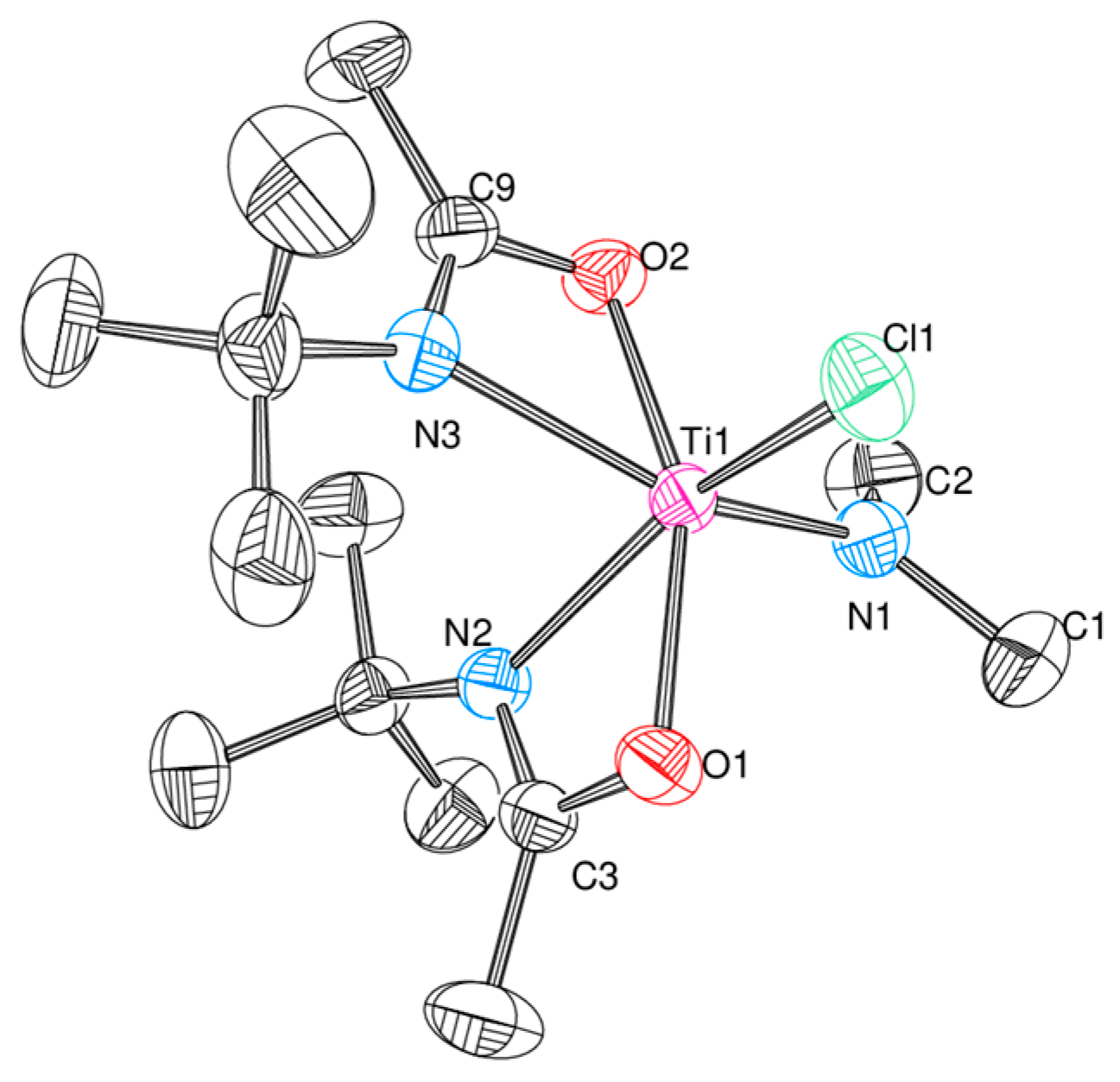Bis(N-tert-butylacetamido)(dimethylamido)(chloro)titanium
Abstract
:1. Introduction
2. Results
3. Discussion
4. Materials and Methods
4.1. Synthesis of N-tert-Butyl Acetamide
4.2. Synthesis of (ON)2Ti(NMe2)(Cl) (1)
4.3. X-ray Structure Determination
Supplementary Materials
Author Contributions
Funding
Data Availability Statement
Acknowledgments
Conflicts of Interest
References
- Bange, C.A.; Waterman, R. Challenges in Catalytic Hydrophosphination. Chemistry 2016, 22, 12598–12605. [Google Scholar] [CrossRef]
- Lau, S.; Hood, T.M.; Webster, R.L. Broken Promises? On the Continued Challenges Faced in Catalytic Hydrophosphination. ACS Catal. 2022, 12, 10939–10949. [Google Scholar] [CrossRef]
- Novas, B.T.; Waterman, R. Metal-Catalyzed Hydrophosphination. ChemCatChem 2022, 14, e202200988. [Google Scholar] [CrossRef]
- Perrier, A.; Comte, V.; Moïse, C.; Le Gendre, P. First Titanium-Catalyzed 1,4-Hydrophosphination of 1,3-Dienes. Chem.—A Eur. J. 2010, 16, 64–67. [Google Scholar] [CrossRef]
- Sakae, R.; Yamamoto, Y.; Komeyama, K.; Takaki, K. Hydrophosphination of Propargylic Ethers with Diphenylphosphine in the Presence of LiHMDS, N-Heterocyclic Carbene, and Ti(NMe2)4. Chem. Lett. 2010, 39, 276–277. [Google Scholar] [CrossRef]
- Zhao, G.; Basuli, F.; Kilgore, U.J.; Fan, H.; Aneetha, H.; Huffman, J.C.; Wu, G.; Mindiola, D.J. Neutral and Zwitterionic Low-Coordinate Titanium Complexes Bearing the Terminal Phosphinidene Functionality. Structural, Spectroscopic, Theoretical, and Catalytic Studies Addressing the Ti−P Multiple Bond. J. Am. Chem. Soc. 2006, 128, 13575–13585. [Google Scholar] [CrossRef]
- Seth, D.M., Jr.; Waterman, R. Photo-Initiated Radical Hydrophosphination at Titanium Compounds Capable of Ti–P Insertion. Organometallics 2023, 42, 1213–1219. [Google Scholar] [CrossRef]
- Rosenberg, L. Mechanisms of Metal-Catalyzed Hydrophosphination of Alkenes and Alkynes. ACS Catal. 2013, 3, 2845–2855. [Google Scholar] [CrossRef]
- Waterman, R. Triamidoamine-Supported Zirconium Compounds in Main Group Bond-Formation Catalysis. Acc. Chem. Res. 2019, 52, 2361–2369. [Google Scholar] [CrossRef]
- Reuter, M.B.; Seth, D.M.; Javier-Jiménez, D.R.; Finfer, E.J.; Beretta, E.A.; Waterman, R. Recent advances in catalytic pnictogen bond forming reactions via dehydrocoupling and hydrofunctionalization. Chem. Commun. 2023, 59, 1258–1273. [Google Scholar] [CrossRef]
- Normand, A.T.; Bonnin, Q.; Brandès, S.; Richard, P.; Fleurat-Lessard, P.; Devillers, C.H.; Balan, C.; Le Gendre, P.; Kehr, G.; Erker, G. The Taming of Redox-Labile Phosphidotitanocene Cations. Chem.—A Eur. J. 2019, 25, 2803–2815. [Google Scholar] [CrossRef]
- Horrillo-Martinez, P.; Leitch, D.C.; Ryken, S.A.; Thomson, R.K.; Beard, J.D.; Patrick, B.O.; Schafer, L.L.; Giesbrecht, G.R. Titanium amidate complexes as active catalysts for the synthesis of high molecular weight polyethylene. Can. J. Chem. 2015, 93, 775–783. [Google Scholar] [CrossRef]
- Kissounko, D.A.; Guzei, I.A.; Gellman, S.H.; Stahl, S.S. Titanium(IV)-Mediated Conversion of Carboxamides to Amidines and Implications for Catalytic Transamidation. Organometallics 2005, 24, 5208–5210. [Google Scholar] [CrossRef]
- Lee, A.V.; Schafer, L.L. Modular N,O-Chelating Ligands: Group-4 Amidate Complexes for Catalytic Hydroamination. Eur. J. Inorg. Chem. 2007, 2007, 2245–2255. [Google Scholar] [CrossRef]
- Zhang, Z.; Schafer, L.L. Anti-Markovnikov Intermolecular Hydroamination: A Bis(amidate) Titanium Precatalyst for the Preparation of Reactive Aldimines. Org. Lett. 2003, 5, 4733–4736. [Google Scholar] [CrossRef]
- Zhang, Z.; Leitch, D.C.; Lu, M.; Patrick, B.O.; Schafer, L.L. An Easy-To-Use, Regioselective, and Robust Bis(amidate) Titanium Hydroamination Precatalyst: Mechanistic and Synthetic Investigations toward the Preparation of Tetrahydroisoquinolines and Benzoquinolizine Alkaloids. Chem.—A Eur. J. 2007, 13, 2012–2022. [Google Scholar] [CrossRef]
- Bexrud, J.A.; Eisenberger, P.; Leitch, D.C.; Payne, P.R.; Schafer, L.L. Selective C−H Activation α to Primary Amines. Bridging Metallaaziridines for Catalytic, Intramolecular α-Alkylation. J. Am. Chem. Soc. 2009, 131, 2116–2118. [Google Scholar] [CrossRef] [PubMed]
- Thomson, R.K.; Zahariev, F.E.; Zhang, Z.; Patrick, B.O.; Wang, Y.A.; Schafer, L.L. Structure, Bonding, and Reactivity of Ti and Zr Amidate Complexes: DFT and X-Ray Crystallographic Studies. Inorg. Chem. 2005, 44, 8680–8689. [Google Scholar] [CrossRef]
- Benzing, E.; Kornicker, W. Dialkylamido-titan(IV)-chloride und -alkoholate. Chem. Ber. 1961, 94, 2263–2267. [Google Scholar] [CrossRef]
- Catherall, A.L.; Hill, M.S.; Johnson, A.L.; Kociok-Köhn, G.; Mahon, M.F. Homoleptic zirconium amidates: Single source precursors for the aerosol-assisted chemical vapour deposition of ZrO2. J. Mater. Chem. C 2016, 4, 10731–10739. [Google Scholar] [CrossRef]
- Bruker AXS Inc. SAINT v8. 37A; Bruker AXS Inc.: Singapore, 2015. [Google Scholar]
- Krause, L.; Herbst-Irmer, R.; Sheldrick, G.M.; Stalke, D. Comparison of silver and molybdenum microfocus X-ray sources for single-crystal structure determination. J. Appl. Crystallogr. 2015, 48, 3–10. [Google Scholar] [CrossRef] [PubMed]
- Sheldrick, G. SHELXT: Integrating space group determination and structure solution. Acta Crystallogr. Sect. A 2014, 70, C1437. [Google Scholar] [CrossRef]
- Sheldrick, G.M. Crystal structure refinement with SHELXL. Acta Crystallogr. Sect. C-Struct. Chem. 2015, 71, 3–8. [Google Scholar] [CrossRef] [PubMed]
- Hubschle, C.B.; Sheldrick, G.M.; Dittrich, B. ShelXle: A Qt graphical user interface for SHELXL. J. Appl. Crystallogr. 2011, 44, 1281–1284. [Google Scholar] [CrossRef]
- Farrugia, L.J. WinGX and ORTEP for Windows: An update. J. Appl. Crystallogr. 2012, 45, 849–854. [Google Scholar] [CrossRef]




| Distance (Å) | Angle (Degrees) | ||
|---|---|---|---|
| Ti1–N1 | 1.8759(14) | C2–N1–C1 | 111.85(15) |
| Ti1–O2 | 1.9795(12) | C2–N1–Ti1 | 128.56(12) |
| Ti1–O1 | 1.9925(12) | C1–N1–Ti1 | 119.29(12) |
| Ti1–N2 | 2.1921(13) | N1–Ti1–Cl1 | 100.41(4) |
| Ti1–N3 | 2.2052(14) | O2–Ti1–Cl1 | 106.11(4) |
| Ti1–Cl1 | 2.3142(8) | O1–Ti1–Cl1 | 92.93(3) |
| Ti1–C3 | 2.5033(16) | N2–Ti1–Cl1 | 153.45(4) |
| Ti1–C9 | 2.5072(16) | N3–Ti1–Cl1 | 91.50(4) |
Disclaimer/Publisher’s Note: The statements, opinions and data contained in all publications are solely those of the individual author(s) and contributor(s) and not of MDPI and/or the editor(s). MDPI and/or the editor(s) disclaim responsibility for any injury to people or property resulting from any ideas, methods, instructions or products referred to in the content. |
© 2024 by the authors. Licensee MDPI, Basel, Switzerland. This article is an open access article distributed under the terms and conditions of the Creative Commons Attribution (CC BY) license (https://creativecommons.org/licenses/by/4.0/).
Share and Cite
Seth, D.M., Jr.; Waterman, R. Bis(N-tert-butylacetamido)(dimethylamido)(chloro)titanium. Molbank 2024, 2024, M1786. https://doi.org/10.3390/M1786
Seth DM Jr., Waterman R. Bis(N-tert-butylacetamido)(dimethylamido)(chloro)titanium. Molbank. 2024; 2024(1):M1786. https://doi.org/10.3390/M1786
Chicago/Turabian StyleSeth, Dennis M., Jr., and Rory Waterman. 2024. "Bis(N-tert-butylacetamido)(dimethylamido)(chloro)titanium" Molbank 2024, no. 1: M1786. https://doi.org/10.3390/M1786
APA StyleSeth, D. M., Jr., & Waterman, R. (2024). Bis(N-tert-butylacetamido)(dimethylamido)(chloro)titanium. Molbank, 2024(1), M1786. https://doi.org/10.3390/M1786







